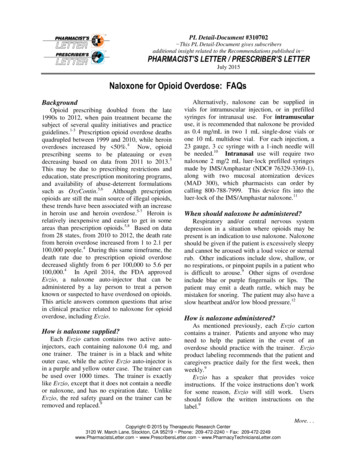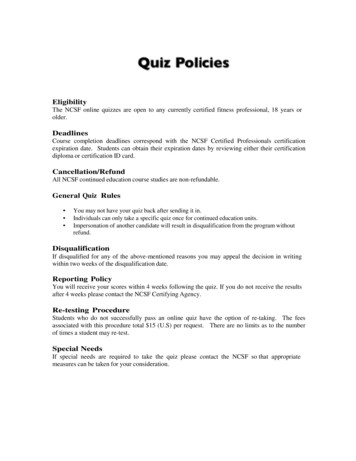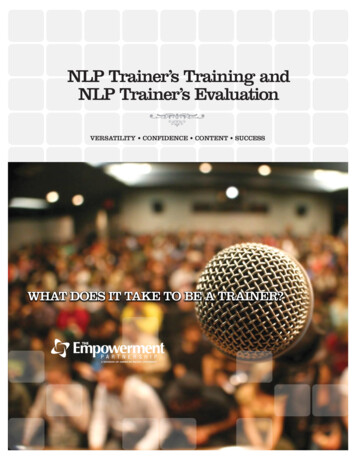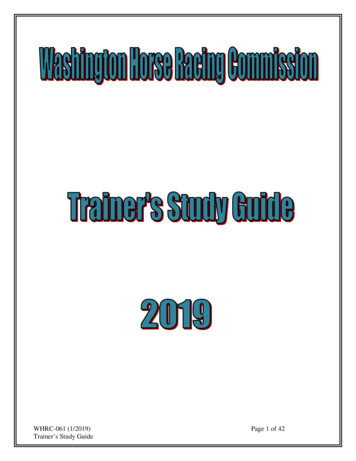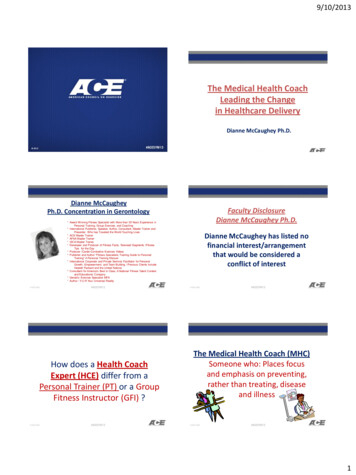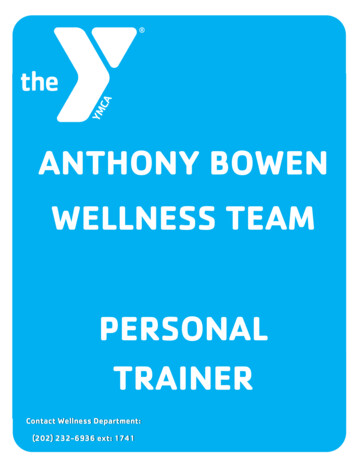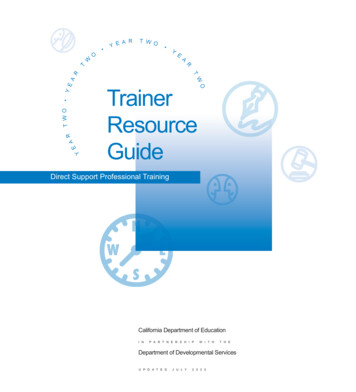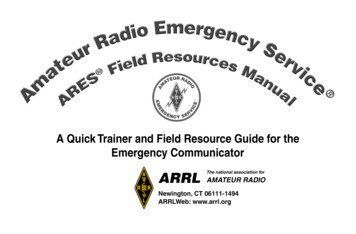
Transcription
A Quick Trainer and Field Resource Guide for theEmergency CommunicatorARRLThe national association forAmateur RadioNewington, CT 06111-1494ARRLWeb: www.arrl.orgPage 1
ForewordThis manual is intended to serve as a quick trainer and reference for amateurs deployed in the field foremergency services work, primarily through the ARRL Amateur Radio Emergency Service (ARES). It providesbasic program information, forms and operating aids. A number of templates can be customized for thelocal area to include reference information such as important phone numbers, emergency frequencies, maps,organizational details and so forth.ARRL Membership and Volunteer Programs DepartmentNewington, ConnecticutAugust 2019ARES and Amateur Radio Emergency Service are registered servicemarks ofthe American Radio Relay League, Incorporated.Page 2
Table of ContentsTopicPageFirst Things First5Equipment and Personal Checklists9Basic Emergency Program Information 13 Amateur Radio Emergency Service 14(ARES) National Traffic System (NTS)16 Radio Amateur Civil19Emergency Service (RACES) Incident Command System (ICS)212731354554TopicSection Emergency PlanOperating AidsHurricane InformationAppendices1) FCC Rules2) Third Party Traffic Countries List3) Common Power Connectors4) Mutual Assistance Team(ARESMAT) Concept5) Understanding our MOUs6) Wilderness Protocol ARES Registration Form Incident Report Form Incident Log Sheets7) Emergency CommunicationsCoursesPage 3Page5559677172767880838788899091
NotesPage 4
First Things FirstTopicWhat to Do First in Case of an EmergencyInitial Action ChecklistPage67Page 5
What to Do First in Case of an Emergency1) Check that you and your family are safe and secure before you respond as an ARES volunteer.2) Check that your property is safe and secure before you respond as an ARES volunteer.3) Monitor (put your assigned local ARES emergency netfrequency here).4) Follow the instructions you receive from the ARES officials in charge on the above frequency.5) Contact your local Emergency Coordinator, or his/her designee, for further instructions.Page 6
Initial Action ChecklistThe net control station and/or ARES officials on the designated emergency net will provide additionalinstructions, including information on frequencies used for other resource and tactical nets. Normally, aresource net will enroll volunteers and provide information on how you can assist.Be prepared to operate. Check all equipment and connections.Check in with your assigned contact. Deploy to assignment with “Ready” kit.Obtain tactical call sign for your location/assignment.Initiate personal event log (use form at end of this booklet).Enter assigned frequency(s) on log sheet and on emergency/frequency plan.Use log form to record messages handled.Use a formal message form when a precise record is required.Use tactical call sign for your location, and observe FCC’s 10-minute ID rule.Monitor your assigned frequency at all times. Notify NCS if you have to leave.Page 7
NotesPage 8
Equipment and Personal ChecklistsTopicPageBasic Deployment Equipment Checklist10Extended Deployment (72 Hour) Equipment Checklist11About Your “Ready Kit”12Page 9
Basic Deployment Equipment ChecklistWhen responding to an emergency event, or even a training exercise, there is a minimum set of equipmentand personal gear you should bring with you to get the job done. Basic items include:2-meter hand-held2-meter mag-mount antenna and coaxEarphonePaper and pencilARES ID cardExtra batteriesAppropriate clothingFood and waterThe majority of these items should be kept in a “Ready Kit.” Just pick it up on your way out the door fordeployment. You might also consider the items on the following list for inclusion in this ready kit, designed toallow you to stay in the field for up to 72 hours.Page 10
Extended Deployment (72 hour)Equipment ChecklistThree day change of clothesLiquid refreshmentsExtra coaxFoul weather gearFirst aid kitRF connectors and adaptersToilet articlesThroat lozengesPower, audio and otherShelter (tent and sleeping bag)Prescriptionsconnectors and adaptersPortable stove; (mess kit withAspirin or other pain relieverBatteriesAdditional radios, packet gearToolboxWaterproof matchesPower supplies, chargersSoldering iron and ctrical and duct tapeAlarm clockPatch cordsSafety glassesThree day supply of water andAntennas with mountsLog booksSWR bridge (VHF and HF)Message formscleaning kit)food/snacksPage 11
About Your “Ready Kit”Power—Your 72-hour kit should have several sources of power in it, with extra battery packs and an alkalinebattery pack for your handheld. For mobile VHF and UHF radios, larger batteries are needed. Gel-cell or deepcycle marine batteries are good sources of battery power, and you must keep them charged and ready go. It is alsowise to have alternate means available to charge your batteries during the emergency. You can charge smallerbatteries from other larger batteries. You can build a solar charging device. If you’re lucky, you may have accessto a power generator that can be used in place of the normal electrical lines. Have more battery capacity than youthink you might need. Have several methods available to connect your radios different power sources.Gain Antennas—You can expect to need some kind of gain antenna for your handheld, as well as anadditional gain antenna that can be used on either your handheld or your mobile rig. The extra antenna might beneeded by someone else, or your first antenna might break. For VHF and UHF, you can build a J-pole from TVtwinlead for an inexpensive and very compact antenna. Have several lengths of coax in your kit, totaling at least50 feet, and barrel connectors to connect them together.Personal—Include staples: water, or a reliable water filtration and purification system; enough food for threedays; eating utensils, a drinking cup and, if needed, a means of cooking your food. Shelter is also important.Here, you are only limited by the size of your kit and the thickness of your wallet. Some hams plan to use theirRVs as shelter, conditions permitting. Other disaster conditions may make the use of an RV impossible, so youshould have several different plans for shelter. Light is important psychologically during an emergency. Makesure that you have several light sources available. Various battery-powered lights are available, and lanterns thatuse propane or other fuel are also good possibilities.Page 12
Basic Emergency ProgramInformationPage1416171920212324Page 13
Amateur Radio Emergency Service (ARES)The ARRL Amateur Radio Emergency Service (ARES) consists of licensed amateurs who have voluntarilyregistered their qualifications and equipment for communications duty in the public interest when disasterstrikes. Membership in ARRL or any other local or national organization is not required to join ARES orparticipate in ARES activities. ARRL membership is, however, required for the leadership appointmentsdescribed here. Because ARES is an Amateur Radio service, only licensed amateurs are eligible formembership.ARES OrganizationThere are three levels of ARES organization—section, district and local. At the section level, the SectionEmergency Coordinator (SEC) is appointed by the Section Manager (SM) and works under his supervision.(The SM is elected by the ARRL members in the section.) In most sections, the SM delegates to the SEC theadministration of the section emergency plan and the authority to appoint District Emergency Coordinators(DECs), Assistant District Emergency Coordinators (ASEC's) and local Emergency Coordinators (ECs) tohelp him run the ARES program in the section. An Assistant Section Emergency Coordinator may beappointed by either the SM or SEC.Most of the ARES organization and operation gets accomplished at the local level. The local level is wheremost emergencies occur and where ARES leaders make direct contact with the ARES member-volunteers andwith officials of the partners to be served. The local EC is therefore the key contact in the ARES. The EC isPage 14
appointed by the SEC, usually on the recommendation of the DEC (if there is one). Depending on how the SEC hasset up the section for administrative purposes, the EC may have jurisdiction over a small community or a large city,an entire county or even a group of counties. Whatever jurisdiction is assigned, the EC is in charge of all ARESactivities in his area, not just one interest group, one agency, one club or one band.In large sections, the SEC has the option of grouping EC jurisdictions into “districts” and appointinga District EC to coordinate the activities of the local ECs. In some cases, the districts may conform to theboundaries of governmental planning or emergency operations districts, while in others they are simplybased on repeater coverage or geographical boundaries.Special-interest groups are headed up by assistant emergency coordinators (AECs). Assistant ECs aredesignated by the EC to supervise activities of groups operating in certain bands, especially those groups thatplay an important role at the local level, but they may be designated in any manner the EC deemsappropriate. These assistants, with the EC as chairman, constitute the local ARES “planning committee” andthey meet together to discuss problems and plan projects to keep the ARES group active and well trained.There are any number of different situations and circumstances that might confront an EC, and his ARESunit should be organized in anticipation of them. There is no specific point at which organization ceases andoperation commences. Both phases must be concurrent because a living organization is a changing one, andthe operations must change with the organization.Page 15
National Traffic System (NTS)The National Traffic System (NTS) is designed to meet two principal objectives: 1) rapid movement of trafficfrom origin to destination, and 2) training amateur operators to handle written traffic and participate in directednets. NTS operates daily and consists of four different net levels—Area, Region, Section, and Local. The fourlevels operate in an orderly time sequence to make a definite flow pattern for traffic from origin to destination.Local NetsLocal nets are those covering small areas such as a community, city, county or metropolitan area, not acomplete ARRL section. They usually operate at VHF (typically 2-meter FM) at times and on days mostconvenient to their members. Some are designated as emergency (ARES) nets that do not specialize in traffichandling. Local nets are intended mainly for local delivery of traffic. Some NTS local nets operate on a dailybasis, just as do other nets of the system, to provide outlets for locally originated traffic. They also routethe incoming traffic as closely as possible to its actual destination before delivery—a matter of practice ina procedure that might be required in an emergency. Most local nets and even some section nets in smallersections are using repeaters to excellent effect. Average coverage on VHF can be extended tenfold or moreusing a strategically located repeater, and this can achieve a local coverage area wide enough to encompassmany of the smaller sections.Section NetsCoverage of the section may be accomplished by individual stations reporting in, by representatives ofNTS local nets, or both. The section may have more than one net (a CW net, a VHF net and an SSB net,Page 16
for example). Section nets are administered by an appointed Section Traffic Manager (STM) or designatedNet Managers (NMs). The purpose of the section net is to handle traffic within the section and distributetraffic coming to the section from higher NTS levels. The section net also puts traffic bound for destinationsoutside the section in the hands of the person who is designated to report into the next-higher NTS level (theregion level). A high level of participation by amateurs within the section is desirable to carry out all of theseresponsibilities.Operation During DisastersWhen a disaster situation arises, NTS is capable of expanding its cyclic operation into complete or partialoperation as needed. ECs in disaster areas determine the communications needs and make decisions regardingthe disposition of local communications facilities, in coordination with agencies to be served. The SEC, afterconferring with the affected DECs and ECs, makes his recommendations to the Section Traffic Manager and/orNTS net managers at section and/or region levels. The decision and resulting action to alert the NTS regionmanagement may be performed by any combination of these officials, depending upon the urgency of thesituation. While the EC is, in effect, the manager of ARES nets operating at local levels, and therefore makesdecisions regarding their activation, managers of NTS nets at local, section, region and area levels are directlyresponsible for activation of their nets in a disaster situation. They activate their nets at the behest of and on therecommendation of ARES or NTS officials at lower levels.Page 17
Types of Emergency NetsTactical Net—The Tactical Net is the front line net employed during an incident, usually used by a singlegovernment agency to coordinate with Amateur Radio operations within their jurisdiction. There may be severaltactical nets in operation for a single incident depending on the volume of traffic and number of agenciesinvolved. Communications include traffic handling and resource recruiting.Resource Net—For larger-scale incidents, a Resource Net is used to recruit operators and equipment insupport of operations on the Tactical Nets. As an incident requires more operators or equipment, the ResourceNet evolves as a check-in place for volunteers to register and receive assignments.Command Net—As the size of an incident increases and more jurisdictions become involved in theincident, a Command Net may become necessary. This net allows the incident managers to communicate witheach other to resolve inter- or intra-agency problems, particularly between cities or within larger jurisdictionalareas. It is conceivable that this net could become cluttered with a high volume of traffic. It may also benecessary to create multiple command nets to promote efficiency.Open and Closed Nets—A net may operate as an open or “free form” net, or as a closed net where a netcontrol station (NCS) is used to control the flow of transmissions on the channel. Typically, when the amount oftraffic is low or sporadic, a net control isn’t required and an open net is used. Stations merely listen before theytransmit. When a net is declared a “closed” net, then all transmissions must be directed by the NCS.Page 18
Radio Amateur Civil Emergency Service (RACES)RACES is a part of the Amateur Radio Service that provides radio communications for civil-preparednesspurposes only, during periods of local, regional or national civil emergencies. These emergencies are notlimited to war-related activities, but can include natural disasters such as fires, floods and earthquakes. RACESis administered by local/county/state emergency management agencies, with guidance from the FederalEmergency Management Agency (FEMA).Operating ProcedureAmateurs operating in a local RACES organization must be officially enrolled in the local civil preparednessgroup. RACES operation is conducted by amateurs using their own primary station licenses and by existingRACES stations. The FCC no longer issues new RACES (WC prefix) station call signs. Operator privileges inRACES are dependent upon, and identical to, those for the class of license held in the Amateur Radio Service.All of the authorized frequencies and emissions allocated to the Amateur Radio Service are also available toRACES on a shared basis.Although RACES was originally based on potential use for wartime, it has evolved over the years. This isalso true of the meaning of civil defense (which is also called civil preparedness or emergency management),which now encompasses all types of emergencies.Page 19
While operating in a RACES capacity, RACES stations and amateurs registered in the local RACESorganization may not communicate with amateurs not operating in a RACES capacity. (Of course, suchrestrictions do not apply when RACES stations are operating in a non-RACES—such as ARES—amateurcapacity.) Only civil preparedness/emergency management communications can be transmitted (as definedin the FCC Rules). Test and drills are permitted only for a maximum of one hour per week. All test and drillmessages must be clearly identified as such.ARES and RACESAlthough RACES and ARES are separate entities, the ARRL advocates dual membership and cooperativeefforts between both groups whenever possible. An ARES group whose members are all enrolled in andcertified by RACES may operate in an emergency with great flexibility. Using the same operators and thesame frequencies, an ARES group also enrolled as RACES can “switch hats” from ARES to RACES andRACES to ARES to meet the requirements of the situation as it develops. For example, during a “nondeclaredemergency,” ARES can operate under ARES, but when an emergency or disaster is officially declared bygovernment emergency management authority, the operation can become RACES with no change in personnelor frequencies.Page 20
Incident Command System (ICS)The Incident Command System (ICS) is a management tool that is being adopted by professional emergencyresponders throughout the country. ICS provides a coordinated system of command, communications,organization and accountability in managing emergency events. Amateur Radio operators should be familiarwith the system, as well as how they will interface with agencies employing ICS.Integral to the ICS is the concept of Unified Command. There is only one boss, the Incident Commander,who is responsible for the overall operation. For any incident, a number of functions must be performed,ranging from planning and logistics to handling the press. The functional requirements of planning, logistics,operations and finance are always present despite the size of the incident. They may be handled by a singleindividual for a small incident or a “Command Staff” in a large incident. Another characteristic of ICS is “spanof control.” In simple terms, any manager should only directly manage a small number of people. ICS uses thenumber of five for organizational purposes. The number five isn’t hard and fast, but it provides a usefulorganizational guideline.How does the Amateur Radio volunteer fit into the Incident Command System? We are expected to becommunicators, and within the ICS, this would place us in the Logistics Section in the Service Branch as part ofthe Communications Unit. The Communications Unit provides all communications services for the operation. Atraining course, “IS-200.c —Basic Incident Command System,” is available as part of the FEMA IndependentStudy Program at https://training.fema.gov/is/crslist.aspxPage 21
National Incident Management System (NIMS)The National Incident Management System (NIMS) has been developed to help emergency managers andresponders from different jurisdictions work together more effectively during emergencies and disasters. TheNIMS provides a set of standardized organizational structures, such as the Incident Command System, andstandardized processes and procedures. More information about NIMS is available from the FEMA Web site.See “IS-700.b —National Incident Management System (NIMS), An Introduction” found at https://training.fema.gov/is/crslist.aspxPage 22
NotesPage 24
Hazardous Material IncidentDeploymentsTopicHAZMAT IncidentsHAZMAT Incident GuidelinesPage2830Page 27
HAZMAT IncidentsThe term “hazardous materials” (HAZMAT) refers to any substances or materials which, if released in anuncontrolled manner (spilled, for example), can be harmful to people, animals, crops, water systems or otherelements of the environment. The list is long and includes explosives, gases, flammable and combustible liquids,flammable solids or substances, oxidizing substances, poisonous and infectious substances, radioactive materialsand corrosives.One of the major problems is to determine what chemicals are where and in what quantities. Variousorganizations in the US have established or defined classes or lists of hazardous materials for regulatorypurposes or for the purpose of providing rapid indication of the hazards associated with individual substances.As the primary regulatory agency concerned with the safe transportation of such materials in interstatecommerce, the US Department of Transportation (DOT) has established definitions of various classes ofhazardous materials, established placarding and marking requirements for containers and packages, and adoptedan international cargo commodity numbering system.The DOT requires that all freight containers, trucks and rail cars transporting these materials displayplacards identifying the hazard class or classes of the materials they are carrying. The placards are diamondshaped, 10 inches on a side, color-coded and show an icon or graphic symbol depicting the hazard class. Theyare displayed on the ends and sides of transport vehicles. A four-digit identification number may be displayedon the placard or on an adjacent rectangular orange panel.Page 28
If you have spent time on the roads you have undoubtedly seen these placards or panels displayed on trucksand railroad tank cars. You may recognize some of the more common ones, such as 1993, which covers amultitude of chemicals including road tar, cosmetics, diesel fuel and home heating oil. Or you may have seentankers placarded 1203 filling the underground tanks at the local gasoline station.In addition to the placards, warning labels must be displayed on most packages containing hazardousmaterials. The labels are smaller versions of the placards (4 inches on a side). In some cases, more than onelabel must be displayed, in which case the labels must be placed next to each other. In addition to labels for eachof the DOT hazard classes, other labels with specific warning messages may be required. Individual containersalso have to be accompanied by shipping papers (if you can safely get close enough!) which contain the propershipping name, the four-digit ID number and other important information about the hazards of the material.Details of the placards and emergency response procedures can be found in the comprehensive DOTEmergency Response Guidebook, copies of which may be available for review from local civil preparednessofficials or your police, sheriff or fire department. You may also want to consult your Local EmergencyPlanning Committee (LEPC) or State Emergency Response Commission (SERC) concerning what role AmateurRadio might have in your local plan. For more information about hazardous materials in general, contactFEMA, Technological Hazards Division, 500 C St SW, Washington, DC 20472, or online at n-contacts. More information is also available from the Pipelineand Hazardous Materials Safety Administration (PHMSA), Office of Hazardous Materials Safety, online athttps://www.phmsa.dot.gov.Page 29
HAZMAT Incident GuidelinesApproach the scene cautiously—from uphill and upwind. If you have binoculars, use them! Try to identify the material by any one of the following: The four-digit number on a placard or orange panel The four-digit number (preceded by the initials “UN/NA”) on a shipping paper or package The name of the material on the shipping paper, placard or package.Call for help immediately and let the experts handle the situation. Do not attempt to take any action beyondyour level of training. Know what you are capable of doing.Page 30
Basic Operating PrinciplesTopicPrinciples of Repeater OperationPrinciples of Disaster CommunicationPage3233Page 31
Principles of Repeater Operation1. Use minimum power. Otherwise, especially in heavily populated areas, you run the risk of keying morethan one repeater, thus causing unnecessary interference. Low power also conserves batteries.2. Use simplex, whenever possible. ARRL recommends 146.52 MHz, but it’s a good idea to have at leastone other simplex channel available. Use a gain antenna at fixed locations for simplex operation.3. Observe the “pause” procedure between exchanges. When it is your turn to transmit, after thetransmitting station stands by, count to two or three before pressing your transmit switch. This gives others withurgent traffic a chance to check in.4. Listen much, transmit little. Announce your presence on a repeater when you are certain of being ableto assist in an emergency, and don’t tie it up with idle chatter.5. Monitor your local ARES net frequency when you are not otherwise busy.6. Think before you talk. Stick to facts, control your emotions. Remember, during an emergency is the timewhen you are most apt to act and speak rashly. Anyone with an inexpensive public service band receiver canmonitor.7. Articulate, don’t slur. Speak close to your mike, but talk across it, not into it. Keep your voice down.In an emergency situation you may get excited and tend to shout. Talk slowly, calmly—this is the mark of anexperienced communicator.Page 32
Principles of Disaster Communication1. Keep transmissions to a minimum. In a disaster, crucial stations may be weak. All other stations shouldremain silent unless they are called upon. If you’re not sure you should transmit, don’t.2. Monitor established disaster frequencies. Many ARES localities and some geographical areas haveestablished disaster frequencies where someone is always (or nearly always) monitoring for possible calls.3. Avoid spreading rumors. During and after a disaster situation, especially on the phone bands, you mayhear almost anything. Unfortunately, much misinformation is transmitted. Rumors are started by expansion,deletion, amplification or modification of words, and by exaggeration or interpretation. All addressedtransmissions should be officially authenticated as to their source. These transmissions should be repeated wordfor word, if at all, and only when specifically authorized.4. Authenticate all messages. Every message which purports to be of an official nature should be writtenand signed. Whenever possible, amateurs should avoid initiating disaster or emergency traffic themselves. Wedo the communicating; the agency officials we serve supply the content of the communications.5. Strive for efficiency. Whatever happens in an emergency, you will find hysteria and some amateurs whoare activated by the thought that they must be sleepless heroes. Instead of operating your own station full timeat the expense of your health and efficiency, it is much better to serve a shift at one of the best-located and bestequipped stations, suitable for the work at hand, manned by relief shifts of the best-qualified operators. Thisreduces interference and secures well-operated stations.Page 33
6. Select the mode and band to suit the need. It is a characteristic of all amateurs to believe that theirfavorite mode and band is superior to all others. The merits of a particular band or mode in a communicationsemergency should be evaluated impartially with a view to the appropriate use of bands and modes. There is, ofcourse, no alternative to using what happens to be available, but there are ways to optimize available resources.7. Use all communications channels intelligently. While the prime object of emergency communicationsis to save lives and property (anything else is incidental), Amateur Radio is a secondary communications means.Normal channels are primary and should be used if available. Amateurs should be willing and able to use anyappropriate emergency channels—Amateur Radio or otherwise—in the interest of getting the message through.8. Don’t “broadcast.” Some stations in an emergency situation have a tendency to emulate “broadcast”techniques. While it is true that the general public may be listening, our transmissions are not and should not bemade for that purpose.9. NTS and ARES leadership coordination. Within the disaster area itself, the ARES is primarilyresponsible for emergency communications support. The first priority of those NTS operators who live in ornear the disaster area is to make their expertise available to their Emergency Coordinator (EC) where and whenneeded. For timely and effective response, this means that NTS operators should talk to their ECs before thetime of need so that they will know how to best respond.Page 34
Message FormatsTopicDisaster Welfare Message FormARRL Message Form InstructionsARRL Message PrecedencesARRL Radiogram FormARRL Message Handling InstructionsARRL Numbered Radiograms for Possible“Relief Emergency Use”Page363739404142Page 35
Disaster Welfare Message FormNumberPrecedenceHXStation of OriginTO:CheckPlace of OriginTime FiledDateMessage Receipt or Delivery InformationOperator and station:Sent to:Delivered to:Date: Time:Telephone number:(Circle not more than two standard texts from list below)ARL ONEARL TWOARL THREEARL FOURARL FIVEARL SIXARL SIXTY FOURTimeDateEveryone safe here. Please don’t worry.Coming home as soon as possible.Am in hospital. Receiving excellent care and recovering fine.Only slight property damage here. Do not be concerned about disaster reports.Am moving to new location. Send no further mail or communications. Will inform you ofnew address when relocated.Will contact you as soon as possible.Arrived safely atTelephoneSignaturePage 36Name
ARRL Message Form InstructionsEvery formal radiogram message originated and handled should contain the following four maincomponents in the order given. The numbers and letters refer to corresponding information on the e
A Quick Trainer and Field Resource Guide for the Emergency Communicator. Page 2 This manual is intended to serve as a quick trainer and reference for amateurs deployed in the field for emergency services work, primarily through the ARRL Amateur Radio Emergency Service (ARES). It pr


